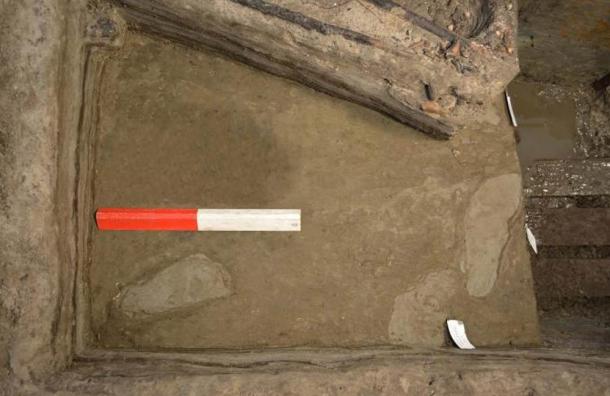25 November, 2014 - 00:39 aprilholloway
5,500-year-old complete hand axe unearthed in prehistoric seabed in Denmark
5500년 전, 석기시대에 쓰인 돌도끼가 원형 그대로 발견돼 학계를 놀라게 했다. 이 도끼는 지금이라도 사용할 수 있을 정도로 나무 자루 부분도 완벽하게 보존돼 있던 것이다.
덴마크 롤란-팔스테르 박물관은 29일(현지시간) 성명을 통해 덴마크 남동부 롤란 섬에서 나무 자루가 달린 석기시대의 희귀한 돌도끼를 발굴했다고 밝혔다.
이번 발굴 조사에 참여한 고고학자 쇠렌 앙케르 쇠렌센은 “손잡이는 약 30cm로, 이처럼 손잡이가 남아 있는 경우는 매우 특별한 것”이라고 설명했다. 이 돌도끼가 완벽하게 보존될 수 있었던 이유로는 묻혀 있는 곳이 진흙으로 공기에 노출이 안돼 모양을 유지할 수 있던 것으로 연구팀은 보고 있다. 이번 조사 과정에서는 나무 자루가 달린 도끼 총 14점 외에도 활 2점, 배를 젓는 노 1점이 함께 발굴됐다. 이들 유물은 모두 땅속에 똑바로 세워진 채 묻혀 있었다.
이는 이들 유물이 의식에 바쳐진 제물이며 의도적으로 묻힌 것을 보여준다고 연구팀은 설명했다.
연구팀은 앞으로 롤란 섬에서 독일의 페마른 섬을 연결하는 수중 터널 공사가 시작되기 전까지 남은 1년여간 발굴 작업에 박차를 가해 고대 의식에 대한 단서를 확보할 방침이다. 한편 이들은 이달 초에도 해당 발굴지에서 고대 인간의 발자국들을 발견한 바 있다.
Archaeologists from the Museum Lolland-Falster in Denmark made an extremely rare discovery when they unearthed a complete hand axe with handle still attached in what was once a seabed in prehistoric times. The 5,500-year-old artifact was found in what has been described as a ‘ritual hot bed’, in which a series of tools and other artifacts had been purposely placed vertically in the earth.
Excavations just east of Rødbyhavn have been underway ahead of the construction of the Femern Belt Fixed Link, an 18km tunnel between Scandinavia and Germany. The dig site has already yielded some incredible finds, including 5,000-year-old footprints, which were found in close proximity to river barriers for fishing. Archaeologists believe the prints were left by fishermen who waded out into the silted seabed to tend to the barriers.

Stone Age footprints discovered near Rødbyhavn in Denmark. Credit: Museum Lolland-Falster.
Archaeologists also found an oar, two bows, and fourteen axe shafts, but were stunned to come across a complete narrow-necked flint axe in almost perfect condition. The artifacts had been preserved as a result of the unique conditions of the silted seabed, enabling even organic material to remain intact.
”To find such a well-preserved shafted axe is incredible,” Søren Anker Sørensen, an archaeologist with Museum Lolland-Falster, said in a press release made by the Museum Lolland-Falster.
The archaeological team believe that the dig area must have had a ritual significance because the axe and other items had been intentionally placed into the earth standing up vertically. Evidence of burial customs and sacrificial rituals during the Neolithic period are not uncommon in areas of marshes and wetlands in Scandinavia.
Excavations are continuing and researchers expect to find many more artifacts that they hope will shed more light on the ritual practices conducted by the ancient inhabitants of Scandinavia.
A video (in Danish) showing archaeologists working on the dig site, and featuring the discovery of the ancient footprints can be viewed below:
Featured image: The newly-discovered complete hand axe. Credit: Museum Lolland-Falster
'고고학 뉴스' 카테고리의 다른 글
| 인간의 불 사용 시점을 알려주는 이스라엘 동굴의 유물 (0) | 2014.12.16 |
|---|---|
| 54만년 전 호모 에렉투스가 남긴 ‘최고 작품’ 발견 (네이처紙) (0) | 2014.12.04 |
| 네안데르탈인은 현생인류의 하위종이 아니었다 (0) | 2014.11.21 |
| 유아매장지로 풀어낸 신대륙 정착민들의 미스터리 (0) | 2014.11.14 |
| 선사미술에 영향을 준 청각의 착각 (0) | 2014.11.03 |





